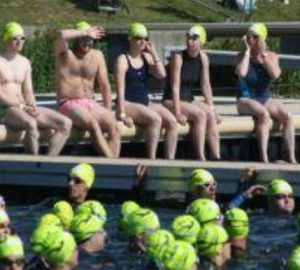Seven things to think about for open water swimming races in rough conditions
The first indication I had that the Spetses Swim* would be a little rougher than I’d anticipated was in the sea taxi that brought us over from the southern tip of the Peloponnese to the island. I’m convinced our boat took off and flew multiple times as it bounced over the waves. This was late in the afternoon. We convinced ourselves that the wind would calm down overnight and we’d have better conditions the next morning.
But that didn’t happen. Instead, a sudden squall blew through just after dark and flattened many of the event exhibitors’ tents and banners. And while the sky was a beautiful clear blue the next morning, the wind was still blowing and the sea looked even more choppy than the day before. At first we feared the swim would be cancelled but it was merely postponed by two hours. And while the sea did settle a little in that time, it was definitely still lively.
Still, if we wanted perfectly calm conditions we’d swim in pools, or at least very sheltered lakes. To me, and I’m sure to many other open water swimmers, rougher conditions, so long as they are safe, are not something we shy away from. Sure, if you’re doing a long distance solo swim, it’s usually preferable if it’s calm, but in a race it’s the same for everyone. If you embrace the conditions and look forward to the challenge, you’ll have a much more enjoyable swim. In the 5km race in Spetese, I managed a respectable 5th overall and I won my age group (conveniently for me I’ve just moved up an age group this year and it often, but not always, helps to be the youngest), so I thought I’d share a few thoughts on how to race well in rough conditions.
1. Start conservatively.
This is actually my advice for any long distance swim. I think most swimmers start most races too fast. When conditions are rough, it’s even more important to conserve energy at the start so you can stay feeling strong throughout the swim.
2. Stay calm
This is especially important at the start when other swimmers around you will be going too fast and fighting for position. In rough conditions it’s harder to hold your line and you are more likely to have bumps and collisions with other swimmers. Start with the assumption that all contact is accidental and do not respond or retaliate in any way. Stay calm, find your own space and keep swimming.
Stay calm at the start (conditions will get rougher as soon as you escape the harbour)
3. Breathe to the side that’s most comfortable
One of the supposed advantages of being able to breathe both sides is that you can turn your face away from incoming waves. However, if – like me – you have a strongly preferred side, you will probably find it easier and more comfortable to breathe that side whatever the conditions. Yes, practise breathing to your non-dominant side in training so you can do it if you really need to or if there’s a tactical advantage (such as sighting or watching the opposition), but don’t worry if you can’t. I’ve not yet come across a situation where it’s been essential to breathe to my non-dominant side. It’s more important to stay calm, relaxed and comfortable, and you’ll probably swallow less water if you breathe to your preferred side.
4. Monitor your technique but be flexible
It’s unlikely you’ll be able to maintain the perfect form, rhythm and tempo you’ve developed in the pool when conditions get rough, but try to keep in mind what it feels like and stay as close to it as you can. Some commentators suggest stroke modifications such as a higher, straighter arm recovery and a faster stroke rate for rough water. That’s worth experimenting with to see if it works for you. I find ramping up my stroke rate can work for short bursts of speed, such as when trying to catch another swimmer in order to draft, but can be quickly exhausting if it leaves you fighting the water. Instead, I try to find a natural rhythm in rough water that seems to fit with the waves, and this is often slower than my flat-water stroke rate. The important thing is that it conserves energy. Relax and enjoy the ride.
5. Be vigilant when drafting
If you use drafting as a racing technique (and I appreciate that many people just prefer to do their own swim) then you need to more vigilant than in flat conditions. Drafting close to someone’s hip is especially challenging as you will be thrown about by waves, so give yourself more space than usual. Drafting behind someone’s feet is often a better option (but please don’t keep tapping the toes of the person in front). It’s much easier to lose contact with other swimmers in rough conditions so you need to pay attention and work harder to keep your draft.
6. Sight more, but less frequently
Spotting where you are going is much harder in rough conditions. Frequently when you look up, all you see is a wave heading towards you. In flat conditions, a single quick lift of your eyes just above the surface is often enough to give you all the information you need. That’s usually not the case in rough water. Rather than sighting say once every six or eight strokes, like I would do in a lake, I might lift my head for two, three or even four stroke cycles in a row until I’ve spotted what I’m looking for. I then try to take more strokes – say ten to twelve – with my head down to try to counterbalance the extra sighting strokes I’ve needed.
7. Don’t worry about the time
I’ve given up wearing a watch in open water events because time is a very unsatisfactory way to measure your performance. Rough conditions will slow you down. Everyone knows this, yet I still see people climbing out of the water and looking disappointed after they glance at their watch. You will probably swim further too in rough conditions because sighting is harder, and that will also result in a slower time. Forget the minutes and seconds and instead ask yourself if you paced the swim well, if you maintained good technique and if you enjoyed yourself.
*The Spetses Swim takes place on the same weekend as the Spetses Mini Marathon in October each year. In 2016 there was a 3km option (from the mainland to the Island) and a 5km option. We will have a full report on the event in a forthcoming issue of the magazine but if you’re looking for a late season, warm water swim with a fantastic atmosphere, this is a good choice.






